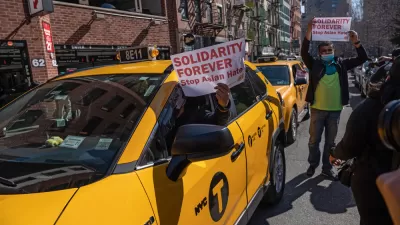Transit officials quickly rescinded a decision to halt public transit service in the city of Petersburg.

Wyatt Gordon reports on the ongoing effort at Petersburg Area Transit (PAT) to balance transit service with safety in the Tri-Cities region near Richmond in Virginia. PAT held the distinction of being the first transit agency in the nation to shut down service entirely, but the suspension of service only lasted a day.
"Despite taking a number of precautions that have become industry best practices during this pandemic such as eliminating fares, switching to backdoor boarding only, and separating bus operators from the public with plexiglass, PAT’s General Manager, Charles Koonce, still made the drastic decision to stop serving all riders as of last April 1 at 4:30 pm save for 12 people who rely on paratransit," reports Gordon.
Gordon provides a lot more detail on the thought process behind the decision to shut down the transit system, as well as the fallout from the decision for riders relying on the system for mobility.
Eventually, according to Gordon, state officials intervened and service reopened just 36 hours after it had been shut down.
FULL STORY: Bus service for one city in Virginia was completely shuttered for a day. Here’s what happened.

Trump Administration Could Effectively End Housing Voucher Program
Federal officials are eyeing major cuts to the Section 8 program that helps millions of low-income households pay rent.

Planetizen Federal Action Tracker
A weekly monitor of how Trump’s orders and actions are impacting planners and planning in America.

Ken Jennings Launches Transit Web Series
The Jeopardy champ wants you to ride public transit.

Washington Legislature Passes Rent Increase Cap
A bill that caps rent increases at 7 percent plus inflation is headed to the governor’s desk.

From Planning to Action: How LA County Is Rethinking Climate Resilience
Chief Sustainability Officer Rita Kampalath outlines the County’s shift from planning to implementation in its climate resilience efforts, emphasizing cross-departmental coordination, updated recovery strategies, and the need for flexible funding.

New Mexico Aging Department Commits to Helping Seniors Age ‘In Place’ and ‘Autonomously’ in New Draft Plan
As New Mexico’s population of seniors continues to grow, the state’s aging department is proposing expanded initiatives to help seniors maintain their autonomy while also supporting family caregivers.
Urban Design for Planners 1: Software Tools
This six-course series explores essential urban design concepts using open source software and equips planners with the tools they need to participate fully in the urban design process.
Planning for Universal Design
Learn the tools for implementing Universal Design in planning regulations.
Heyer Gruel & Associates PA
Ada County Highway District
Institute for Housing and Urban Development Studies (IHS)
City of Grandview
Harvard GSD Executive Education
Toledo-Lucas County Plan Commissions
Salt Lake City
NYU Wagner Graduate School of Public Service




























